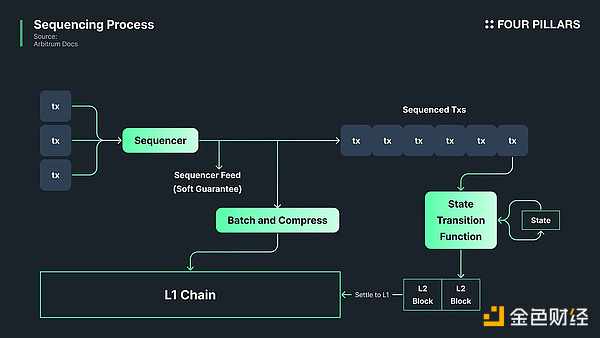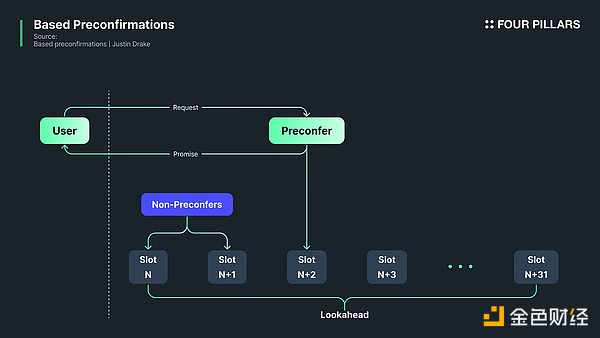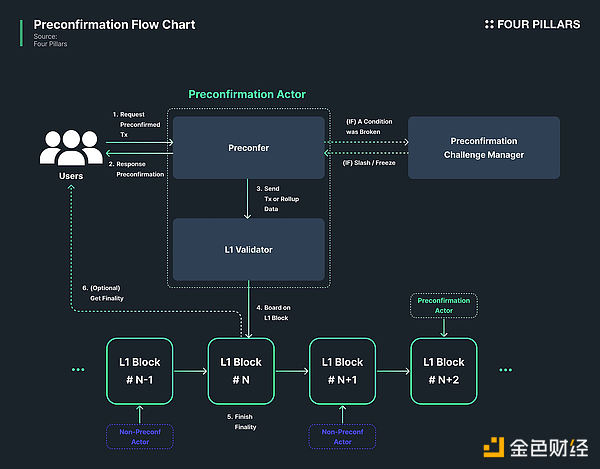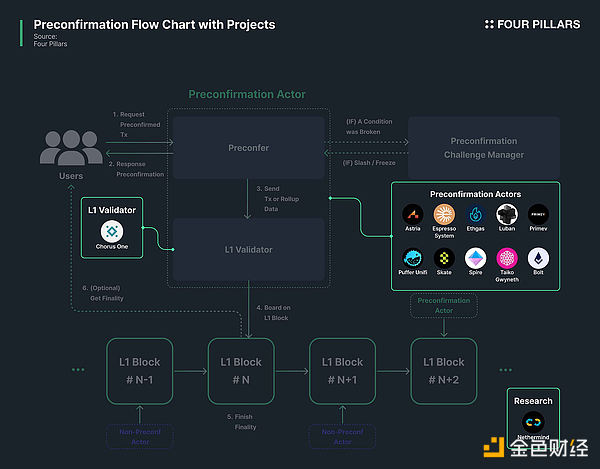Binance CEO Urges Nigerian Government to Release Detained
Binance CEO Richard Teng urges Nigeria to release detained executive Tigran Gambaryan, whose health is deteriorating without proper medical care.
 Dante
Dante
This article starts from the limitations of the current L2 ecosystem and analyzes the specific practices of projects such as Taiko to show how the innovative concept of preconfirmation optimizes the transaction confirmation process and improves user experience. It also reveals the difficulties that the current preconfirmation technology still needs to overcome in the development process, including the dual challenges of technical improvement and ecological sustainability.
Original title: "Preconfirmation (feat. Taiko): Make Ethereum Fast for the First Time!"
Original author: Ingeun Kim : : FP

Key Overview
Taiko is a Layer2 Based Rollup The network aims to achieve full interoperability with Ethereum while promoting the decentralization of the sequencer. To solve the delay problem of transaction final confirmation in the Rollup mechanism, Taiko introduced the concept of "preconfirmation". By guaranteeing the inclusiveness and order of transactions to users in advance, preconfirmation effectively alleviates the inefficiency of the transaction confirmation process in the Rollup mechanism, thereby significantly improving the user experience.
In the Based Preconfirmation model, L1 validators provide users with guarantees of transaction results. Preconfirmers need to pledge margin and comply with the slashing mechanism to ensure the reliability of the system. L2 projects such as Taiko have established reliable transaction finality by introducing the preconfirmation mechanism, creating a more convenient operating environment for services such as DeFi that require real-time confirmation.
Currently, many projects have participated in the construction of the preconfirmation ecosystem. This technological advancement is expected to improve the efficiency of the Ethereum L2 ecosystem, strengthen interoperability with Ethereum, and promote further expansion of the entire ecosystem.
Taiko is steadily moving towards its ultimate goal as an Ethereum Layer2 solution. To achieve this goal, Taiko prioritizes full interoperability with Ethereum, decentralized sequencers, and developer support. It is worth mentioning that Taiko achieves full interoperability with Ethereum through the Based Rollup architecture, while allowing anyone to participate in becoming a sequencer, thereby achieving the decentralization of the sequencer. However, despite the advantages of the Based Rollup model, its structure itself still has some inherent inefficiencies.
This article will take Taiko as an example to deeply analyze the concept of preconfirmation. As a key component in the Layer2 technology stack, preconfirmation is an important step for Rollup to achieve further development.
As the L2 ecosystem expands, numerous projects have emerged, bringing many new concepts and technology stacks. However, despite these significant advances, L2 still has some urgent problems to be solved in terms of efficiency, especially in key areas that affect user experience, where improving efficiency becomes particularly important.
 This architecture ensures security and data immutability by directly leveraging L1's block generation and data availability. However, relying on L1 for final confirmation leads to slower transaction processing speed and limited real-time confirmation capabilities, which is difficult to meet real-time needs from a user's perspective
This architecture ensures security and data immutability by directly leveraging L1's block generation and data availability. However, relying on L1 for final confirmation leads to slower transaction processing speed and limited real-time confirmation capabilities, which is difficult to meet real-time needs from a user's perspective
In addition, many L2 sequencers and verification nodes are currently still centralized. This centralization leads to inefficiencies, such as long transaction confirmation times and possible operational interruptions, which affects the transaction processing efficiency of some Rollups and causes confirmation delays.
The concept of pre-confirmation was proposed to solve the problem of inefficient final confirmation of transactions in L2 networks. Preconfirmation allows users to get confirmation of transactions faster, thereby alleviating the delays and inefficiencies common in the Rollup mechanism.
In the Rollup mechanism, the confirmation process after users submit transactions to L2 is always inefficient. Because the centralized L2 sequencer cannot accurately guarantee when transactions will be confirmed on L1, users are often uncertain about the order and results of transactions. For example, users may need to wait a long time for transactions to be included on L1, which may result in financial losses from executed transactions if the transaction order is wrong or the results are not ideal.
In highly volatile market environments, the problems of delays and order changes are more prominent because users rely on arbitrage and DeFi services. In these cases, transaction delays or order changes will directly lead to lost opportunities. Even users who conduct ordinary transactions may lack confidence in the time and order of transaction confirmation on L1, which in turn raises doubts about the reliability and ease of use of the blockchain.
Therefore, preconfirmation is designed to address these deficiencies, especially to provide a more convenient and reliable trading experience for those users who are most affected by Rollup inefficiencies.
Preconfirmation solves these problems by providing users with guarantees of transaction inclusion, ordering, and execution. It provides "soft confirmations" to users through a centralized L2 sequencer and issues preconfirmation certificates to ensure that the transaction will eventually be included on L1.
The main advantage of soft confirmation is that it improves the user experience. Users can receive confirmation certificates immediately after submitting a transaction, ensuring that the transaction is included on L1 in the expected order, reducing uncertainty, especially in transactions that require fast response such as arbitrage. In addition, preconfirmation also enhances users' trust in the L2 system. As users gain confidence in the secure processing of transactions, the overall usage of the L2 ecosystem will also increase. As a result, preconfirmation plays a key role in improving the efficiency and convenience of Rollup processing.
Although soft confirmation from a centralized sequencer can improve the user experience through expected ordering and results, it relies on trust in the sequencer. Without legal or technical enforcement measures, users can only rely on the reliability of the sequencer. This dependence brings the possibility that transactions may not be included in the correct order, or may not even be included on L1 at all, and cannot provide the stable guarantee that users expect.
Taiko has invested a lot of energy in the implementation of preconfirmation because this approach is highly consistent with the core characteristics of Based Rollup. If Based Preconfirmation can be successfully introduced into Taiko's framework, it will not only significantly reduce the delay of final confirmation of transactions, but also improve the user experience. In addition, this improvement will also activate a variety of previously restricted services, enabling them to run efficiently on the Taiko network.
Before we deeply understand Based Preconfirmation, it is necessary to review some key features of Taiko in order to more fully understand the applicability and advantages of this method.
Taiko fully demonstrates the core features of Based Rollup. It not only achieves full interoperability with Ethereum infrastructure, but also strives to fully align with Ethereum's security mechanism. Taiko adopts the architecture of Based Rollup, which means that it does not rely on a centralized sequencer, but relies on Ethereum's validators to play the role of sequencer, responsible for the ordering of transactions and blocks.
In other words, Taiko's sequencer is the same role as Ethereum's block proposer. This design gives them special responsibilities and incentives, such as obtaining maximum extractable value (MEV) rewards and other benefits of sequencer status. Therefore, when problems arise in Taiko's L2 sequencing process, these sequencers will naturally bear the corresponding responsibilities due to their interest in the Ethereum ecosystem. This mechanism makes Taiko significantly different from other Ethereum L2 projects in terms of operational responsibilities.
In addition, it is worth noting that Taiko's Based Rollup model is designed as "Based Contestable Rollup (BCR)", a structure designed to incentivize healthy competition. Through open and permissionless design, Taiko ensures the decentralization of the system and allows anyone to participate, making the system more fair and transparent.
So, what is the preconfirmation model designed specifically for Based Rollup? The answer is "Based Preconfirmation". This model aims to replace the traditional soft confirmation mechanism with confirmations verified directly on L1.
Based Preconfirmation provides a system in which some L1 validators voluntarily participate and provide preconfirmation services. As sequencers, these validators provide users with verifiable predictions of the results of Rollup transactions. This approach provides users with trusted guarantees of transaction inclusion and ordering, and these guarantees are directly based on L1, thereby enhancing the credibility and reliability of the Rollup process.

The Slashing mechanism has been widely used in Ethereum PoS staking to effectively curb malicious behavior. This mechanism not only strengthens the sense of responsibility of preconfirmers, but also establishes a certain trust foundation between users and preconfirmers.
Two situations will cause preconfirmers to be punished by Slashing:
Liveness Faults: If the preconfirmer fails to include the user's preconfirmed transaction on the chain for any reason, a liveness fault will occur. Since liveness faults are not always intentional, their penalties are relatively mild. Such failures may be caused by network problems or outages in the L1 or L2 blockchain, which prevent transactions from being correctly included on the chain. To protect honest preconfirmers from being unduly punished, the penalty amount for liveness failures is usually negotiated between the user and the preconfirmer.
Safety Faults: If a preconfirmed transaction is included on the chain, but the result is inconsistent with the user's original request, a safety failure occurs. This inconsistency is entirely the responsibility of the preconfirmer, so the penalties for safety failures are usually more severe. The preconfirmer's security deposit will be forfeited in full, regardless of whether the problem was intentional.
To become a preconfirmer in the Based Preconfirmation model, a node (usually an L1 block proposer) must accept the conditions of these slashing mechanisms and stake the required security deposit. Once approved, the preconfirmer can provide services to users and earn income by charging service fees.
This fee model provides significant convenience for users, allowing them to bypass the inherent delays in the final confirmation of Rollup transactions. For example, after a user submits a pre-confirmed transaction through a personal wallet, he can immediately obtain a confirmation certificate from the pre-confirmer.
Pre-confirmers participating in Based Preconfirmation can not only earn additional income by charging fees, but also help optimize the transaction confirmation process of Rollup. This model not only improves the user experience, but also provides a reliable and efficient transaction final confirmation solution for the entire L2 ecosystem, further enhancing its attractiveness and practicality.
This is actually closely related to the core purpose of pre-confirmation. Users are willing to pay for pre-confirmation because it directly solves the inefficiency of Rollup in the final confirmation process of transactions and brings significant convenience to users.
For example, when a user submits a pre-confirmed transaction on an L2 blockchain through a personal wallet, a standard transaction may need to wait for final confirmation, while the user requesting pre-confirmation can immediately get assurance from the pre-confirmer that the transaction can be completed without delay. At this point, the user may even see a green check mark in the wallet interface, clearly indicating that the transaction has been successful.
Take DeFi services as an example. When users exchange tokens on L2 DeFi platforms, pre-confirmation can provide additional protection for related transactions. Typically, the quoted exchange rate or fee of a transaction may be inconsistent with the actual transaction result due to delays. But with pre-confirmation, users can enjoy a fast and efficient transaction final confirmation process, reduce the difference between expected conditions and actual results, and obtain a more reliable service experience.
These application scenarios not only enable developers to provide more accurate services, but also bring users a smoother and more convenient user experience. This dynamic further supports the expansion of the L2 ecosystem while also contributing to the growth of the broader L1 ecosystem. In addition, for the sequencer of Based Rollup, the additional income brought by preconfirmation provides it with a considerable profit model. This design effectively solves some of the traditional weaknesses of Based Rollup, making it an ideal choice for sequencers, both reliable and attractive.
Based Preconfirmation is still a hot research area in Rollup-driven Layer2 projects represented by Taiko. Although this mechanism provides a clear solution for improving L2 performance and scalability while maintaining decentralization, it still faces some challenges that need to be solved in practical applications to achieve wider adoption.
First, when the Preconfer submits a transaction to the block, the user may not be able to obtain an absolute guarantee of transaction inclusion. Although the preconfirmer provides a guarantee for the transaction by staking a margin, this mechanism still cannot completely solve the problem of transaction failure to be included due to external interruptions. Especially when the transaction value is higher than the pre-confirmer's stake, the pre-confirmer may abuse his authority to selectively include or exclude certain transactions, which poses potential risks.
Another significant challenge is the profit model based on pre-confirmation. The main source of income for pre-confirmers is the pre-confirmation fees paid by users. However, if the number of pre-confirmers is insufficient or the participation is not high enough, it may lead to market centralization and monopoly tendencies. In this case, pre-confirmation fees may be artificially raised, increasing the cost for users to conduct fast and efficient transactions, thereby posing a threat to the healthy development of the pre-confirmation ecosystem.
It is worth noting that the concept of Based Preconfirmation is relatively new, having been proposed only about a year ago. It will still take some time for it to become a "key tool" to maximize the speed and efficiency of Rollup-driven L2 solutions. However, with Rollup firmly established as a core component of Ethereum scalability, further exploring pre-confirmation to improve performance marks an important step in the development of L2 technology.
Taiko, in particular, has made significant progress in promoting the implementation of Based Preconfirmation. At the same time, Taiko has collaborated with many partners such as Taiko Gwyneth, Nethermind, Chainbound, Limechain, Primev and Espresso to jointly explore and develop application scenarios of Based Preconfirmation. These collaborations are aimed at promoting the further evolution of the L2 ecosystem, and more details will be discussed in subsequent chapters.
In this chapter, we will explore which projects are actively researching and promoting the development of preconfirmation technology in the Rollup-driven L2 ecosystem. Since the ecosystem is still in its early stages of development, we will use a flowchart to more intuitively display and understand the specific process of preconfirmation.
Pre-confirmation is a complex process that requires close collaboration between L1 and L2, involving multiple roles, each with specific responsibilities. In order to facilitate a more intuitive understanding of this process, I have made a flowchart for a brief overview. It should be noted that this flowchart is intended to help explain the overall logic, so it does not strictly distinguish between the different features of Rollup and Based Rollup, but focuses on the general process at the basic level.
 https://substackcdn.com/image/fetch/w_1272,c_limit,f_auto,q_auto:good,fl_progressive:steep/https%3A%2F%2Fsubstack-post-media.s3.amazonaws.com%2Fpublic%2Fimages%2Fcbb37095-e440-405a-a04a-f978f405333e_3840x3004.png 1272w, https://img.jinse.cn/7318166_watermarknone.png 1456w" sizes="100vw" loading="lazy">
https://substackcdn.com/image/fetch/w_1272,c_limit,f_auto,q_auto:good,fl_progressive:steep/https%3A%2F%2Fsubstack-post-media.s3.amazonaws.com%2Fpublic%2Fimages%2Fcbb37095-e440-405a-a04a-f978f405333e_3840x3004.png 1272w, https://img.jinse.cn/7318166_watermarknone.png 1456w" sizes="100vw" loading="lazy">
Before understanding the specific steps of the flowchart, let's first understand the various roles and functions involved in the pre-confirmation process:
User: Individual users who use the L1 or L2 network are responsible for creating and submitting transactions. If users want to obtain pre-confirmation guarantees, they will send the transaction to the pre-confirmer after writing it.
Preconfirmer: During the pre-confirmation process, the pre-confirmer is responsible for reviewing the transaction and verifying its validity, and then providing the user with a pre-confirmation guarantee. Through pre-confirmation, users can quickly obtain status guarantees for transactions before final settlement. If nodes are not eligible for pre-confirmation, they act as non-preconf actors, mainly processing ordinary transactions rather than pre-confirmed transactions, similar to standard verification nodes.
L1 Validator: Responsible for the final verification of transactions and blocks on the L1 network. Once the preconfirmer submits the transaction data, the L1 validator will verify it and record the final data in the L1 blockchain to ensure the integrity of the transaction and compliance with the consensus rules.
Preconfirmation Challenge Manager: When disputes or problems arise in the preconfirmation process, this role is responsible for investigating the problem and taking appropriate measures to resolve the dispute. This role plays a key role in maintaining the fairness and reliability of the preconfirmation process.
Now, let's sort out the specific process of preconfirmation in the order of the flowchart:
The user sends a transaction request to the preconfirmer among the preconfirmation participants to start the preconfirmation process.
The preconfirmer reviews the transaction and sends a preconfirmation receipt, promising the user that the transaction will be included in the L1 block, thereby providing the user with preliminary final confirmation guarantees.
The pre-confirmer submits the transaction data that needs to be included in the L1 block to the L1 validator. This data may be a single transaction or a summary of data processed by the L2 sequencer.
The L1 validator verifies the submitted transaction data or summary data and records it in the L1 block to ensure that it complies with the blockchain consensus rules.
After a period of time, the L1 block containing the transaction data or summary data reaches finality and the transaction is officially confirmed.
Users can check the final result of the transaction through the L1 node and use the relevant information to raise any potential pre-confirmation disputes or challenges if necessary.
If a transaction is not correctly included on L1 as promised, the pre-confirmer will face penalties from the pre-confirmation challenge manager, such as having their deposit slashed or their staked assets frozen.
The following will provide a detailed analysis of the main projects actively participating in the pre-confirmation ecosystem and their relevant roles in the process. Although these projects occupy specific roles in the flowchart, the responsibilities they actually perform may be slightly different. Therefore, this overview is intended to provide a basic understanding and can be used as a general guide. For clarity, the projects in each category are arranged in alphabetical order.

Preconfer Validators
Astria: Astria is committed to replacing centralized sequencers with a decentralized sequencer network and supporting multiple Rollups to share this network. This design provides Rollups with stronger censorship resistance, faster block finality, and seamless cross-Rollup interactions. To achieve fast block finality, Astria introduces a pre-confirmation feature that enables Rollups to provide fast transaction confirmations and enhanced censorship resistance, significantly improving the user experience.
Bolt by Chainbound: Bolt is a pre-confirmation protocol developed by Chainbound that provides near-instant transaction confirmation services to Ethereum users. It operates based on a trustless participation mechanism and economic collateral, while being compatible with the existing MEV-Boost PBS pipeline, creating new revenue opportunities for proposers. The core function of Bolt is L1 pre-confirmation, which provides instant finality for basic transactions such as transfers and authorizations, thereby improving the user experience. By shifting the responsibility for transaction inclusion from centralized block builders to proposers, Bolt enhances the system's censorship resistance. At the same time, the mortgage proposer registration mechanism ensures a trustless environment that flexibly supports various types of smart contracts.
Espresso System: Espresso System is a protocol dedicated to enhancing interoperability in blockchain ecosystems. It uses the HotShot Byzantine Fault Tolerant (BFT) consensus protocol to achieve fast finality of transaction order and data across multiple chains. Espresso System includes Espresso Network and Espresso Marketplace, which work together to provide fast transaction finality and efficient interoperability, with the goal of improving the scalability and security of the blockchain ecosystem.
Ethgas: Ethgas is a market for trading block space, where transaction matching is managed by a centralized system and on-chain processes are executed through smart contracts. Ethgas provides two main functions: inclusion pre-confirmation (ensuring that a transaction is included within a specified Gas limit) and execution pre-confirmation (ensuring that a transaction reaches a specific state or result). Ethgas focuses on protecting transaction privacy in blockspace transactions and is known for its neutral operational goals.
Luban: Luban focuses on developing a decentralized sequencing layer to connect transaction data between the Ethereum network and Rollup. The sequencing layer is designed as a decentralized system that separates the proposal and execution roles. Luban's pre-confirmation feature significantly improves transaction reliability by ensuring the executableness of transactions before being included in the Ethereum network, while helping to optimize key factors such as transaction fees, Gas prices, and MEV.
Primev:Primev is developing a proposer network integrated with MEV, combining pre-confirmation with MEV functions to build an efficient and reliable peer-to-peer network. This network records the commitment to the execution of Ethereum transactions and incentivizes proposers through a reward or penalty mechanism. Primev allows MEV participants to set specific execution conditions for their transactions, and block builders and validators can commit to meeting these conditions to ensure the pre-confirmation of transactions. Based on EIP-4337, Primev supports flexible pre-confirmation and gas fee options, which not only improves transaction processing efficiency, but also further optimizes the user experience.
Puffer Unifi:Puffer Unifi's Actively Validated Services (AVS) are built on EigenLayer and focus on solving pre-confirmation challenges in the Ethereum ecosystem, especially in the Based Rollup architecture. Puffer Unifi AVS leverages EigenLayer's re-staking capabilities to power a pre-confirmation participation mechanism designed to improve the efficiency of transaction finalization. As Based Rollup grows, the need for reliable pre-confirmation providers continues to grow, and Puffer Unifi AVS aims to meet this demand. Its ultimate vision is to enable efficient pre-confirmation without changing the core protocol, thereby driving sustainable growth in the Ethereum ecosystem.
Skate: Skate's pre-confirmation AVS relies on re-staking assets on EigenLayer to provide economic security for all cross-chain operations. The AVS verifies the bundled data and information required for cross-chain transactions, which are then signed and prepared for execution by Skate's relayers. Through this process, Skate AVS achieves pre-confirmation of data, significantly improving the reliability and efficiency of cross-chain transactions.
Spire: Spire's Based Stack is a Rollup framework based on Ethereum, designed to support developers in building App Chains. The framework allows App Chains to interact directly with Ethereum and customize their sequencing methods, support functions such as cross-chain exchange, and optimize user experience through pre-confirmation. Based Stack supports multiple execution environments, guarantees sequencing income for App Chains, and maintains compatibility with traditional shared sequencers. As an open source project, Based Stack provides developers with complete tools and resources needed to build and manage App Chains, thereby promoting interoperability of App Chain development and the Ethereum ecosystem.
Taiko Gwyneth: Taiko Gwyneth is a Rollup design being developed by Taiko, which is classified as a based Rollup architecture. Its goal is to achieve full interoperability with Ethereum while managing transaction sequencing directly on Ethereum. This design takes full advantage of Ethereum's security and decentralization while providing high throughput and fast final confirmation. Currently, Taiko is running a proposer mechanism to assist in block creation and exploring a pre-confirmation mechanism to promote profitable block production within the community. The mechanism aims to optimize block time scheduling and data publishing efficiency. To achieve these goals, Taiko is working closely with projects such as Nethermind and Gattaca.
L1 Validator
Chorus One: Chorus One is a project that provides verification services and infrastructure for blockchain networks, focusing on staking services in multiple protocols to enhance the stability and security of the network. As an L1 validator, Chorus One's responsibility is to verify transactions and generate blocks, thereby improving the reliability and efficiency of the entire network. Chorus One has recently shown great interest in pre-confirmation technology, even hosting a special event during Devcon 2024.
Research
Nethermind: Nethermind is a project dedicated to developing Ethereum clients and tools, with the core goal of improving the performance and stability of the blockchain network. By introducing advanced optimization techniques, Nethermind actively promotes the improvement of transaction throughput on the Ethereum network. Nethermind has been conducting in-depth research on pre-confirmation technology and has submitted a proposal to Taiko's funding program to accelerate the deployment of pre-confirmation functionality on the Taiko mainnet. This proposal is based on Nethermind's RFP-001 project and will be implemented in two phases: the first phase will test the pre-confirmation function among a limited number of authorized participants; the second phase plans to gradually expand the scope of application of pre-confirmation.
Taiko and many Rollup-based Layer2 projects, whether or not they adopt the Rollup-based architecture, are working to optimize the inefficient transaction final confirmation process in traditional Rollup. By introducing the concept of preconfirmation, these projects are building a transaction confirmation system that enables users to confirm transactions more quickly and reliably. In this way, these projects continue to explore how to improve user experience and build user trust.
Taiko has made full use of its position as a Rollup-based Layer 2 project and actively promoted the implementation of the Preconfirmation-based mechanism to achieve full interoperability and decentralization with Ethereum. Taiko has greatly improved the transaction processing speed and reliability by providing users with fast and reliable transaction final confirmation guarantees, thereby significantly improving the user experience.
However, several industry experts, including Ed Felten of Arbitrum, have pointed out that there is still a lack of mature middleware that can fully support preconfirmation. This shows that the maturity of preconfirmation technology and the profit model of preconfirmers are still facing challenges, which need to be further addressed.
As described in this article, more and more projects and participants are actively entering the preconfirmation field, each bringing unique and innovative solutions to improve the performance and efficiency of Ethereum Layer2. This trend also fits the general law that system concepts are continuously optimized after initial implementation. I believe that this stage marks an important node in the evolution of L2 systems and is also an exciting and positive development in the current L2 ecosystem.
Improving user convenience through preconfirmation may not only have a profound impact on speed and efficiency-oriented fields such as DeFi and games, but may also reconnect Ethereum with previously fragmented parts of the ecosystem by improving the performance of Ethereum Layer2. This performance improvement may enable more Type-1 Ethereum Layer2 projects to achieve deep integration with Ethereum, thereby releasing potential that was previously difficult to obtain due to speed limitations. These developments are bound to have a profound impact on the entire Ethereum ecosystem.
Pre-confirmation is still a challenging and bumpy road. However, pioneers like Taiko are rising to the challenge and focusing on providing more convenience to users. Innovation is never easy, but as a supporter of Ethereum and its Layer2 ecosystem, I sincerely respect and encourage their efforts.
Binance CEO Richard Teng urges Nigeria to release detained executive Tigran Gambaryan, whose health is deteriorating without proper medical care.
 Dante
DanteTrump’s presidential campaign has raised about $3 million in cryptocurrencies, primarily Bitcoin and Ethereum.
 JinseFinance
JinseFinanceGolden Finance launches the 2244th issue of the cryptocurrency and blockchain industry morning report "Golden Morning 8:00" to provide you with the latest and fastest digital currency and blockchain industry news.
 JinseFinance
JinseFinancePandoshi, a rising cryptocurrency, is gaining attention with its successful presale, securing over $500,000 in 48 hours, and the launch of its DeFi wallet. Positioned as a pioneer in decentralized finance, Pandoshi's commitment to innovation and decentralization is drawing considerable interest from the crypto community.
 Joy
JoyPandoshi (PAMBO) secures its position in the cryptocurrency realm with a successful Stage 3 presale sell-out and the launch of its anticipated DeFi Wallet, showcasing its commitment to innovation. Positioned as a practical, user-oriented blockchain solution, Pandoshi emerges as an attractive investment option for those seeking a promising and accessible crypto venture.
 Joy
JoySynthetix's Progressive Stride in DeFi The Andromeda Release signifies Synthetix's unwavering commitment to innovation and user-centric development in the DeFi space. By integrating Core V3, Perps V3, introducing USDC as collateral, and executing a buyback and burn mechanism for SNX tokens, Synthetix sets new industry benchmarks and fosters the DeFi sector's growth and maturity.
 Bernice
BerniceDePIN Network's CESS, a revolutionary CDN and storage network, unveils its roadmap featuring testnet v0.7.7, global nodes, rewards, and token listing, backed by a successful $8 million funding round.
 Kikyo
KikyoIn the dynamic world of cryptocurrency, a newcomer called Pandoshi is gaining recognition for its innovative approaches and impressive achievements in previous fundraising campaigns.
 Zoey
ZoeyAs per the details from a tweet thread by Coinbase, iOS users will be unable to send NFTs from their wallets on iOS devices anymore.
 Others
OthersOver 5,000 portfolio managers are already building their reputation scores on testnet for a headstart once Pollen goes live. Here’s ...
 Bitcoinist
Bitcoinist